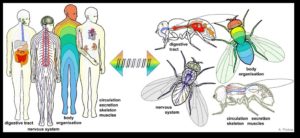Drosophila as a model for human diseases: Several criteria make Drosophila a meaningful organism in which to model human diseases. Essentially, the majority (75%) of disease-related genes are conserved between the fruit fly and humans. Many disease-related genes are important for both human and fly development and were often first described in the fruit fly. Due to the over 100-year-old tradition of naming fly mutations after how they look (the phenotype), many disease-causing genes are named after their fly counterparts, e.g. Hedgehog (abbreviated Hh), Wingless (Wg or Wnt), Grainyhead (Grh or Grh-like).

The fruit fly’s body plan and internal organs have human counterparts in developmental and functional terms. This is partly illustrated by the image above. In terms of organ functionality, we know that many of the cell types that make up human organs have fly counterparts and that these organs accomplish many of the same jobs (digestion, filtration, excretion, oxygenation, buffering starvation, behavior, sensation). Additionally, they produce or secrete much the same proteins or hormones to accomplish these tasks.
To be more specific, during development we can take a human gene and use it to replace the function of a purposefully mutated fly gene. In this way, we can say the fly and human genes are so related they can do the same job (functional orthologs). Understandably, we can only check this relationship in one direction, putting human genes into the fly, not the other way around. It is worth mentioning that the fly has a short life cycle (10 days), so experiments changing fly genes are comparatively fast and compared to other model organisms (rat, mouse, fish), cheap.
Altogether making the small fly an attractive model to quickly determine a gene’s role in either healthy development or in a disease case.
For further reading this site is a great place to start